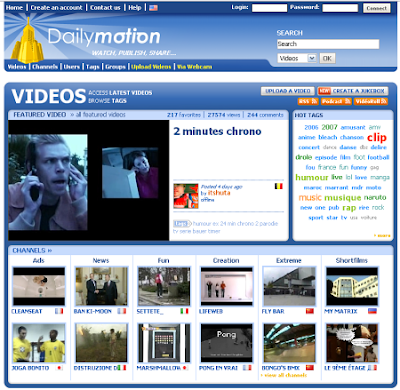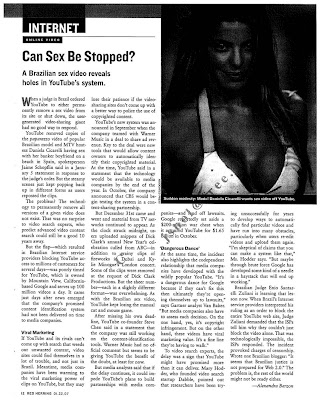While waiting for YouTube to roll out its promised automated takedown service, NBC employs three people responsible for trolling YouTube in search of studio material, sending the site more than 1,000 takedown requests per month.
**********
The New York Times, LAURA M. HOLSON,
LOS ANGELES, Jan. 14 — Did you miss Eminem’s hit movie “8 Mile”? You’re in luck: Many of its rap battles and other major scenes are available for viewing on YouTube, the video-sharing Web site owned by Google. Indeed, until recently, the entire film was there, broken up into 12 nine-minute chunks to get around YouTube’s ban on longer clips.
An 18-year-old YouTube user calling himself Yosickoyo posted the movie six months ago. He declined to give his real name, but said in an e-mail message that he had made the film available as a favor to others who had shared movies. “I just want to thank them by uploading a movie that I have,” he wrote.
NBC Universal, whose Universal Pictures distributed “8 Mile” in 2002, did not appreciate the gesture. The company asked YouTube to take down the clips after it learned of them from a reporter. It was not the first time. NBC Universal has three employees who troll the site every day looking for studio-owned material, and they send more than 1,000 such requests a month to YouTube.
“There is only so much we can do,” said Rick Cotton, NBC Universal’s general counsel, who estimated that more than half the videos on YouTube featuring NBC Universal’s television shows and films were unauthorized. As fast as a clip is taken down, he said, YouTube users “can always put up another.”
As YouTube, with the backing of Google, becomes a powerful force in the media world, Hollywood studios and other entertainment companies are trying to figure out if it is friend or foe. After all, YouTube distributes unauthorized clips of the movies that the studios spend an average of $96 million to make. But it can also help them build tremendous buzz, and that is driving Hollywood to try to work with it instead of against it.
Hoping to avoid some of the problems in the music industry that arose from illegal downloading of songs, all of the major studios — including NBC Universal, Warner Brothers Entertainment, which is owned by Time Warner, and the News Corporation’s 20th Century Fox, are in negotiations with YouTube seeking licensing agreements that would make their content legally available on the site.
In the meantime, they are also pressing YouTube to adopt filtering mechanisms more quickly to keep unlawful material from even showing up. And several media companies are in talks to create their own YouTube-like site, a move some in the industry suggest is a form of posturing to help push the licensing negotiations forward.
“I think studios will sue if they don’t get a licensing deal they like,” said Jessica Litman, a professor at the University of Michigan Law School. “My guess is if I were a movie studio, getting a cut of the money is more profitable than shutting it down. But it’s complicated, very complicated, and it’s only going to get worse.”
Google also has a lot resting on how these copyright issues are resolved, because investors are eager to see whether the $1.65 billion it paid for YouTube was well-spent.
Chris Maxcy, vice president of business development for YouTube, declined to be interviewed, but he said in an e-mail message that YouTube had successfully worked with studios to market their movies and sought deals with studios to make their content more widely available. “In fact, we’re now in discussions with several studios to create both content partnerships and revenue-sharing opportunities,” he wrote.
Much of the content on YouTube, of course, has nothing to do with Hollywood — like the thousands of video blogs created by teenagers with Web cams. But there is enough copyrighted material there to warrant the attention of the studios and many other media companies — everything from the dancing penguins of the new film “Happy Feet” to the black-and-white television clips of the Beatles singing “Help.”
No one knows exactly how much Hollywood-derived content is uploaded to the site without the studios’ consent, but academics and media executives estimate it could be anywhere from 30 percent to 70 percent.
The studios are happy to have some of their content on YouTube. Marc Shmuger, chairman of Universal Pictures, said that for each new release, Universal’s marketing team sends out a digital “tool kit” to sites like YouTube with studio-approved graphics, clips, sound effects and music videos that can be shared. Because “8 Mile” was released four years ago, its kit may have only included trailers and some clips.
“I think that the marketing side of our company and the copyright-protection side have contradictory impulses,” Mr. Shmuger said. “But there is a huge appetite for content, and we are well-advised to recognize that appetite and find constructive ways to feed it.”
Mr. Shmuger said the studios need to embrace sites like YouTube because they are the future of movie marketing. “If you want to be involved in the cultural debate, you have to allow consumers to be more actively involved,” he said. “That’s a different world order which we are not used to.”
One scene Mr. Shmuger said would most certainly not have been part of the “8 Mile” tool kit — one that shows up in 16 separate videos on YouTube — is the climactic rap battle between Eminem’s character Bunny Rabbit and Papa Doc.
But from the perspective of a YouTube user, it is hard to tell which clips are studio-approved and which are not. Some clips from companies like CBS and NBC that have deals with YouTube are fairly easy to identify as authorized material. For the rest, said Pamela Samuelson, co-director of the Berkeley Center for Law and Technology, “what you have is a gap between what people think is O.K. and what is over the line.”
Already, several major music companies, including Universal Music Group, once a corporate sibling to Universal Pictures but now owned by Vivendi, have forged agreements with YouTube, which makes its money from advertising, that allows music to be played in videos for a fee.
So in an odd twist, Eminem’s songs from “8 Mile” are cleared for use on YouTube, while much of the accompanying video is not. In what could be an indication of the kinds of deals the studios might strike, Universal Music earns the higher of two amounts when its songs are used in a video: a flat fee per clip or a percentage of advertising revenue.
“We don’t want to kill this,” said Larry Kenswil, a Universal Music executive. “We see this as a new source of revenue for us.”
Where studios and music companies see the most complicated copyright issue is in the posting of mashups — clips that incorporate video and music from various sources that has been “mashed up” to make something new. Most mashups are made by eager fans as a form of artistic expression or a demonstration of their editing skills.
“I don’t consider any of this stuff piracy,” said Professor Litman of the University of Michigan. “Folks are taking snippets and making them their own.”
One video posted last March, credited to Kusoyaro Productions, includes clips from the 20th Century Fox film “Napoleon Dynamite” that have been cleverly edited to create a new music video for Eminem’s song “Lose Yourself” from “8 Mile.”
The two movies’ heroes couldn’t be more different: Napoleon Dynamite is an awkward teenager in rural Idaho who stuffs his pockets with tater tots, while Eminem’s character in “8 Mile” finds refuge from his trailer-park life by rapping in clubs. The video has been watched more than 60,000 times.
Ron Wheeler, a senior vice president of content protection at Fox Entertainment Group, said that even though Fox was not being paid for the right to use the “Napoleon Dynamite” clips, the company had not asked that the video be taken down.
“We are not in the business of just saying no, but we do consider it unauthorized use,” Mr. Wheeler said.
He predicted, though, that the studio would be saying “no” more often in the future. Fox is working on a policy that will address the issue of mashups in a way that those creating them can understand.
“We will offer as much freedom as legally able, but at the same time it will be less than some people are doing now,” Mr. Wheeler added. “It won’t be ‘anything goes.’ ”
Brian Grazer, a producer of “8 Mile,” said some of the mashups he had seen were “pretty hip.” But he said he, too, viewed them as a form of piracy: “It bothers me artistically. Here’s this thing where you have no control; they are chopping it up and putting your memories in a blender.”
Directors may have a tough time accepting the wild world of mashups, particularly those who have been given control over the final cut of their movies. Mr. Grazer said he believed that Curtis Hanson, who directed “8 Mile,” would not be pleased. “Something like this drives an auteur nuts,” he said. Mr. Hanson did not return calls seeking comment. Eminem, through a spokesman, declined to comment.
But film, television and music companies are not the only ones in Hollywood seeking to protect their rights as online video spreads. The industry’s guilds, too, are exploring what rights directors, writers, producers and actors will be afforded in the digital era. “This is a thorny issue,” Mr. Wheeler said.
The Directors Guild of America is already taking a hard line. The guild’s president, Michael Apted, said in a statement that he and his fellow directors would challenge the unauthorized use of any work. “We will aggressively protect our members’ creative and economic rights,” he said.
For an indication of ways that the relationship between studios and YouTube might unfold, many in the industry are pointing to two recent events. Universal Music sued MySpace, the social networking site, for copyright infringement. And when Google closed the YouTube deal it set aside as much as $200 million for potential copyright litigation.
YouTube said in September that it would introduce a new mechanism to filter out unauthorized videos and let owners claim their content by the end of the year, but it is still being developed.
Mr. Cotton, the NBC Universal lawyer, said that the YouTube removal-request game could continue for only so long. “Sand is running out of the hourglass,” he said. “Companies aren’t prepared to sit by and not let this be addressed.”


